
|   |

|   |
39th InterArt Vikram Sarabhai International Fest: Images of sexist disharmony, universal harmony, lyrical romance - Dr. S D Desai e-mail: sureshmrudula@gmail.com January 8, 2015 Darpana Academy’s 39th InterArt Vikram Sarabhai International Arts Festival (28, 29, 30 December, Natarani) opened with Ru/apture, a one-hour choreographic work with a loaded title. It chiefly relies on contemporary dance and from time to time draws from Indian classical dance. Significantly, young choreographer and Bharatanatyam dancer Revanta Sarabhai carries forward through this piece Mrinalini Sarabhai’s legacy of taking up a social issue through art in an engaging way. 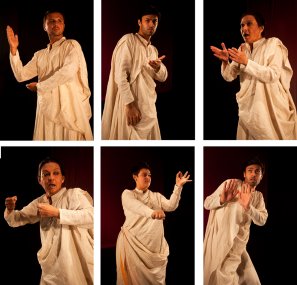
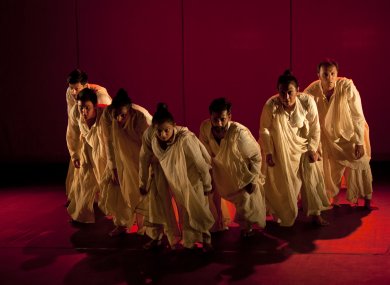
Ru/apture
What gives it character is that, remaining nonverbal all through, it engagingly communicates with clusters of visual images, very well supported by nonstop music, punctuated with easy-paced bols of Bharatanatyam movement a couple of times for beats, and with loud thuds and pauses of disturbing silence highlighted with a bare moving sound track, from time to time. Somewhere in the middle, at lightning speed, the choreography changes track for much quicker, more energetic movement against the backdrop turning reddish. Except in that distinctive sequence, colour nowhere changes, if I recall accurately. The players (Mallilka, Revanta, Anahita, Pooja, Padma Kumar, Manoj, Hemavati … ) are all, without makeup, deglamourized in off-white flowing costumes. Formations keep changing and the players’ action remains well-coordinated (during the countdown to the day of performance, they are known to have rehearsed at times till close to wee hours of the morning!). There is no linear narrative. Images of domestic violence, sexism (fists and hands raised; a young woman seen stabbed, another moved like a marionette, someone’s hair pulled; corpses, real and metaphorical, moved) and turmoil seem to lead to a transition with smiles of awakening not yet free from unease, the swollen male ego strutting about getting challenged and ruptured. Disturbing, the work seems to state, but there is a transitional chaos. The awakening, however, is reassuring. It is also significant that a male choreographer takes up the issue with the empathy art bestows. In its aesthetic appeal and in terms of the impact it leaves, however, there is scope in the work to attain a smoother flow yet and get even more suggestive. Strains that soothe 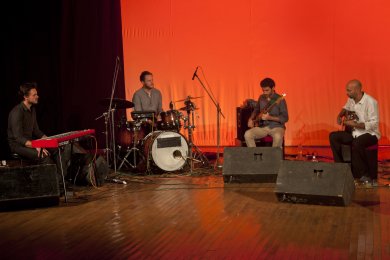
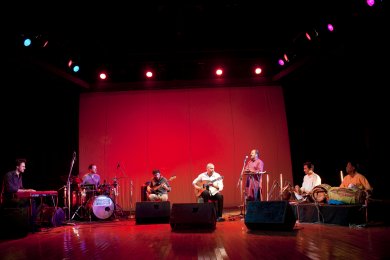
Cross Currents
Within minutes of the strains of the guitar (Giuliano), bass (Domenico), drums (Joost) and keyboard (Macsween) flowing down the stage and rising up to the last row, an expectant packed audience on the second day of the Fest knew they were in for an evening pleasing to the ear. The strains were soft, not extravagantly cacophonous. Collectively they sought to soothe the listeners from within with harmony, not rouse their passions with high-decibel sounds. And that precisely is the function of music. The four likeable musicians, all highly proficient, form the Kefaya group (London), which is widely travelled across the world, receiving and absorbing influences and gets their music to voice disagreement and protests on social issues. Their debut album is Radio International. A distinguishing trait of the group in performance is their nonverbal interaction with a smile, with no bodily jerks with pronouncedly strong rhythm, which adds to the musical harmony they together create. “Our music,” Giuliano Modarelli, said, “celebrates what we believe in.” With their idea of music, they already had the listeners swaying to their tunes when Manikandan (ghatam, khanjira) and Palanivelu (mridangam, tavil) joined. With them, when Kefaya played a piece based on Italian folk music, their sounds merged and one could visualize and tap footsteps, too! Then Darpana’s most dependable versatile musician Jayan Nair entered, unassuming as ever. The vocalist began with Raagamaala. Next, his alaap, its measured notes coming from within and rising without towards the sky, was received with admiration and softly accompanied by Kefaya musicians. His devotional lines in ‘Jaya Jaya Tunge’ in Malayalam, steeped in Sanskrit, when completed, were rousingly cheered. After the Quartet’s interlude in a slightly faster tempo, Jayan resumed on simple beats and turned to a delectable Amruta Varshini, emulating the rain following thunder and lightning. Kefaya, with Jayan still lending support, concluded ‘Cross Currents’ on the second day of InterArt Fest at Natarani, with a short solemn rendering dedicated to the overall theme of the Fest - a strong disapproval of sexist discrimination. The band having close affinity with Indian music - no wonder because they have studied it - received a spontaneous standing ovation. Puppetry that celebrates love 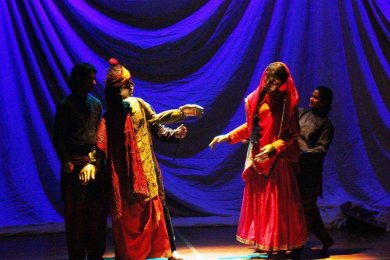
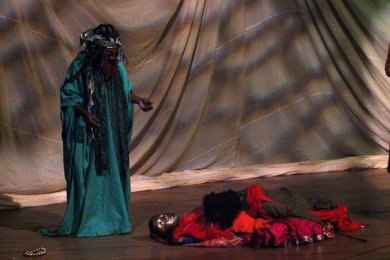
Heer ka Waris
Both the form and the communication in Ishara Puppet Theatre’s Heer ka Waris on the final day had welcome distinctive qualities. Puppetry, with string pullers behind the curtain and right on stage, live drama with young actors, and poetry, verbal as well as visual, enhanced with music, combine to make a communication of contemporary and universal relevance. The story of modern day young lovers - handsome all lovers look! - finds an elevating parallel in the tragic romance of the legendary pair Heer and Ranjha as captivatingly narrated by Warish Shah. With the all-time great 18th century Sufi poet’s lyrical touches to the tale and the scriptwriter Maheep Singh’s skilled dialogues, Heer ka Waris assumes the power of suggestion. Quite in the beginning, the Fakir says, ‘Heer to Ranjha ho gayi!’ The modern girl in love says, ‘Kurbaani to stree ko deni padti hai.’ She adds, ‘Deevare-n aurat jaat se oonchi hoti hai-n!’ This gets tellingly echoed at another level when giant size masks of self-proclaimed guardians of values spy on and talk down to them from above the full-sized curtains. At one stage, one of them shows his disdain for a lover with these words: ‘Khuda ke gharme-n kaafir?’ Heer ka Waris entertains children and makes elders, anywhere across the world, think. It exposes what we call religion as a sham and our idea of social respectability. At the same time, it celebrates one of the noblest sentiments human beings are capable of at a young age. “The course of true love,” Shakespeare’s Lysander wisely for his age declared, “never did run smooth.” And yet, young lovers everywhere remain steadfast to their love even when they know the consequence! Dr. SD Desai, a professor of English, has been a Performing Arts Critic for many years. Among the dance journals he has contributed to are Narthaki, Sruti, Nartanam and Attendance. He guest-edited Attendance 2013 Special Issue. His books have been published by Gujarat Sahitya Academy, Oxford University Press and Rupa. After 30 years with a national English daily, he is now a freelance art writer. |